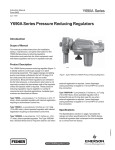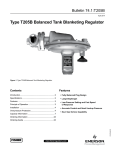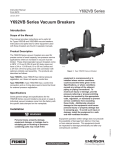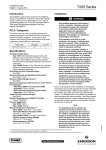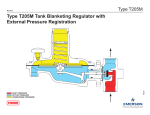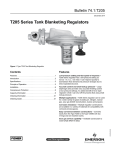Download Emerson T205 Instruction Manual
Transcript
T205 Series Instruction Manual April 2014 T205 Series Tank Blanketing Regulators Table of Contents Introduction ............................................................................1 Specifications ........................................................................2 Principle of Operation ............................................................3 Installation .............................................................................3 Overpressure Protection........................................................5 Startup, Adjustment and Shutdown .......................................5 Adjustment.............................................................................6 Shutdown...............................................................................6 Maintenance ..........................................................................6 Parts Ordering .......................................................................9 Figure 1. Type T205 Tank Blanketing Regulator Parts List................................................................................9 ! Introduction WARNING Failure to follow these instructions or to properly install and maintain this equipment could result in an explosion, fire and/or chemical contamination causing property damage and personal injury or death. Fisher® regulators must be installed, operated and maintained in accordance with federal, state and local codes, rules and regulations and Emerson Process Management Regulator Technologies Inc. (Regulator Technologies) instructions. If the regulator discharges process fluid or a leak develops in the system, service to the unit may be required. Failure to correct trouble could result in a hazardous condition. This Instruction Manual provides instruction for installation, startup, maintenance and parts ordering information for the T205 Series tank blanketing regulators. Product Description T205 Series tank blanketing regulator is a direct-operated and spring-loaded regulator. The regulator prevents a stored liquid from vaporizing into the atmosphere, reduces liquid combustibility and prevents oxidation or contamination of the product by reducing its exposure to air. T205 Series maintains a slightly positive pressure and thereby reduces the possibility of tank wall collapse during pump out operation. T205 Series is available in two configurations: Type T205 for internal pressure registration requiring no downstream control line and Type T205M which has a blocked throat and a downstream control line connection for external pressure registration. D103748X012 Call a qualified service person to service the unit. Installation, operation and maintenance procedures performed by unqualified person may result in improper adjustment and unsafe operation. Either condition may result in equipment damage or personal injury. Only a qualified person must install or service the T205 Series regulator. Scope of the Manual www.fisherregulators.com T205 Series Specifications The Specifications section on this page provides the ratings and other specifications for the T205 Series. Factory specification such as type, maximum inlet pressure, maximum temperature, maximum outlet pressure, spring range and orifice size are stamped on the nameplate fastened on the regulator at the factory. Product Configurations Type T205: Tank blanketing regulator with outlet pressure range of 1-inch w.c. to 7 psig / 2.5 mbar to 0.48 bar in seven different spring ranges and has internal pressure registration requiring no downstream control line. Type T205M: Similar to Type T205 but has a blocked throat and a downstream control line connection for external pressure registration. Body Sizes and End Connection Styles See Table 1 Maximum Allowable Inlet Pressure(1) See Table 1 Maximum Operating Inlet Pressure(1) See Table 2 Maximum Outlet (Casing) Pressure(1) Gray Cast iron: 35 psig / 2.4 bar WCC Carbon steel or CF8M/CF3M Stainless steel: 75 psig / 5.2 bar Maximum Emergency Outlet Pressure to Avoid Internal Parts Damage(1) With Nitrile (NBR) or Fluorocarbon (FKM) diaphragm: 35 psig / 2.4 bar With Fluorinated Ethylene Propylene (FEP) diaphragm: 10 psig / 0.69 bar Outlet (Control) Pressure Ranges(1) See Table 3 Shutoff Classification per ANSI/FCI 70-3-2004 Class VI (Soft Seat) Pressure Registration Type T205: Internal Type T205M: External Material Temperature Capabilities(1)(2) Elastomer Parts Nitrile (NBR): -40 to 180°F / -40 to 82°C Fluorinated Ethylene Propylene (FEP): -20 to 180°F / -29 to 82°C Fluorocarbon (FKM): 40 to 300°F / 4 to 149°C Ethylene Propylene Diene (EPDM): -20 to 225°F / -29 to 107°C Perfluoroelastomer (FFKM): 0 to 300°F / -18 to 149°C Body Materials Gray Cast Iron: -20 to 300°F / -29 to 149°C WCC Carbon Steel: -20 to 300°F / -29 to 149°C CF8M/CF3M Stainless Steel: -40 to 300°F / -40 to 149°C Spring Case Vent Connection 1/4 NPT Diaphragm Case Control Line Connection (Type T205M) 1/2 NPT Approximate Weight 17.7 pounds / 8 kg 1. The pressure/temperature limits in this Instruction Manual and any applicable standard or code limitation should not be exceeded. 2. See Table 5 for operating temperature ranges for available trim combinations. Table 1. Body Sizes, End Connection Styles and Maximum Allowable Inlet Pressures BODY SIZE Inch DN 3/4 or 1 20 or 25 MAXIMUM ALLOWABLE INLET PRESSURE BODY MATERIAL END CONNECTION STYLES(1) psig bar Gray Cast iron NPT 150 10.3 WCC Carbon steel NPT, CL150 RF, CL300 RF or PN 16/25/40 RF 200 13.8 CF8M/CF3M Stainless steel(2) 1. All flanges are welded. Weld-on flange dimension is 14 inches / 356 mm face-to-face. 2. Pipe nipples and flanges are 316 Stainless steel for flanged body assemblies. Table 2. Maximum Operating Inlet Pressures MAXIMUM OPERATING INLET PRESSURE ORIFICE SIZE 1 to 2.5 Inches w.c. / 2.5 to 7 Inches w.c. / 7 to 16 Inches w.c. / 0.5 to 1.2 psig / 1.2 to 2.5 psig / 2.5 to 4.5 psig / 4.5 to 7 psig / 2.5 to 6.2 mbar 6.2 to 17 mbar 17 to 40 mbar 34 to 83 mbar 83 to 172 mbar 0.17 to 0.31 bar 0.31 to 0.48 bar Outlet (Control) Outlet (Control) Outlet (Control) Outlet (Control) Outlet (Control) Outlet (Control) Outlet (Control) Pressure Setting Pressure Setting Pressure Setting Pressure Setting Pressure Setting Pressure Setting Pressure Setting Inch mm psig bar psig bar psig bar psig bar psig bar psig bar psig bar 1/8 3.2 200(1) 13.8(1) 200(1) 13.8(1) 200(1) 13.8(1) 200(1) 13.8(1) 200(1) 13.8(1) 200(1) 13.8(1) 200(1) 13.8(1) 1/4 6.4 60 4.1 102 7.0 102 7.0 102 7.0 200(1) 13.8(1) 200(1) 13.8(1) 200(1) 13.8(1) 3/8 9.5 30 2.1 40 2.8 100 6.9 60 4.1 125 8.6 125 8.6 125 8.6 1/2 13 15 1.0 15 1.0 8 0.55 30 2.1 30 2.1 30 2.1 30 2.1 9/16 14 10 0.69 10 0.69 20 1.4 10 0.69 30 2.1 30 2.1 30 2.1 1. Inlet pressure is limited to 150 psig / 10.3 bar for gray cast iron bodies. 2 T205 Series Table 3. Outlet (Control) Pressure Ranges and Spring Information OUTLET (CONTROL) PRESSURE RANGE Inch w.c. mbar SPRING PART NUMBER SPRING COLOR 1 to 2.5 2.5 to 6.2 1B558527052(1)(2) 2.5 to 7 6.2 to 17 SPRING WIRE DIAMETER SPRING FREE LENGTH Inch mm Inch mm Orange 0.072 1.8 3.25 82.6 1B653827052(1) Red 0.085 2.2 3.63 92.2 7 to 16 17 to 40 1B653927022 Unpainted 0.105 2.7 3.75 95.2 0.5 to 1.2 psig 34 to 83 1B537027052 Yellow 0.114 2.9 4.31 109 1.2 to 2.5 psig 83 to 172 1B537127022 Green 0.156 4.0 4.06 103 2.5 to 4.5 psig 0.17 to 0.31 bar 1B537227022 Light Blue 0.187 4.8 3.94 100 4.5 to 7 psig 0.31 to 0.48 bar 1B537327052 Black 0.218 5.5 3.98 101 1. To achieve the published outlet pressure range the spring case must be installed pointing down. 2. Do not use Fluorocarbon (FKM) diaphragm with this spring at diaphragm temperatures lower than 60°F / 16°C. Principle of Operation T205 Series tank blanketing regulator controls the vapor space pressure over a stored liquid. When liquid is pumped out of the tank or vapors in the tank condense, the pressure in the tank decreases. Tank pressure is sensed by the actuator diaphragm. Spring force pushes the pusher post assembly upward, the valve disk moves away from the orifice, allowing the gas flow to increase. See Figures 2 and 3. When pressure in the tank increases, the actuator diaphragm is pushed downward. Through the action of the pusher post assembly, lever and valve stem, the valve disk moves closer to the orifice reducing gas flow. Installation ! WARNING Personal injury, property damage, equipment damage or leakage due to escaping gas or bursting of pressure-containing parts may result if this regulator is overpressured or installed where service conditions could exceed the limits given in the Specifications section or where conditions exceed any ratings of the adjacent piping or piping connections. Refer to Overpressure Protection section for recommendations on how to prevent service conditions from exceeding those limits. To avoid such injury or damage, provide pressure-relieving or pressure-limiting devices (as required by the appropriate code, regulation or standard) to prevent service conditions from exceeding limits. Additionally, physical damage to the regulator could cause personal injury or property damage due to escaping gas. To avoid such injury or damage, install the regulator in a safe location. Note If the regulator is shipped mounted on another unit, install that unit according to the appropriate Instruction Manual. 1. Only personnel qualified through training and experience shall install, operate and maintain a regulator. For a regulator that is shipped separately, make sure there is no damage to or debris in the regulator. Also ensure that all tubing and piping are clean and unobstructed. 2. The regulator may be installed in any position as long as the flow through the body is in the direction indicated by the arrow on the body. When using a Type T205 or T205M regulator, for proper operation to achieve the published capacities at low setpoint, the spring case barrel should be installed pointed down as shown in Figure 1. For complete actuator drainage, the regulator should be installed as shown in Figure 4. If continuous operation of the system is required during inspection or maintenance, install a threevalve bypass around the regulator. ! WARNING A regulator may vent some gas to the atmosphere. In hazardous or flammable gas service, vented gas may accumulate and cause personal injury, death or property damage due to fire or explosion. Vent a regulator in hazardous gas service to a remote, safe location away from air intakes or any hazardous area. The vent line or stack opening must be protected against condensation or clogging. 3. To keep the spring case vent (key 26, Figure 7 or 8) from being plugged or the spring case from collecting moisture, corrosive chemicals or other foreign material, point the vent down or otherwise protect it. The diaphragm casing (key 4, Figure 7 or 8) may be rotated in order to obtain desired positioning. 4. To remotely vent the regulator, remove the vent (key 26, Figure 7 or 8) and install obstruction-free tubing or piping into the 1/4 NPT vent tapping. Provide protection on a remote vent by installing a screened vent cap into the remote end of the vent pipe. 3 T205 Series VALVE DISK STEM LEVER PUSHER POST PIPE PLUG DIAPHRAGM PITOT TUBE CONTROL SPRING TYPE Y602-1 VENT INLET PRESSURE OUTLET PRESSURE ATMOSPHERIC PRESSURE Figure 2. Type T205 with Internal Registration Operational Schematics VALVE DISK O-RING STEM SEAL PUSHER POST CONTROL LINE CONNECTION THROAT SEAL TYPE Y602-1 VENT CONTROL SPRING INLET PRESSURE OUTLET PRESSURE ATMOSPHERIC PRESSURE Figure 3. Type T205M with External Registration Operational Schematics 4 T205 Series HORIZONTAL PIPELINE VENT POINTED DOWN HORIZONTAL PIPELINE DOWNSTREAM CONTROL LINE TYPE T205 TYPE T205M INLET PRESSURE OUTLET PRESSURE ATMOSPHERIC PRESSURE LOADING PRESSURE Figure 4. Type T205 Actuator Casing Drainage Schematics 5. Type T205M requires a downstream control line. Be sure to install the control line before putting the regulator into operation. Make the control line as short and straight as possible and do not install it in a location where flow may be turbulent. Restrictions in the control line can prevent proper pressure registration. When using a hand valve, it should be a full flow valve, such as a full port ball valve. Install the control line sloping downward toward the tank to prevent condensation buildup and avoid low points (or traps) that could catch liquid. The sensing line must enter the tank above the liquid level at a point that senses the vapor space pressure and is free from turbulence associated with tank nozzles or vents. The control line pipe should be at least 1/2-inch / 13 mm in diameter and increase 1 pipe size for every 10 feet / 3.05 m of control line, with setpoint less than 5-inches w.c. / 12 mbar. 6. An upstream shutoff valve is recommended to simplify maintenance to the regulator. It is advisable to install a pressure gauge between the upstream shutoff valve and the blanketing valve. Overpressure Protection ! WARNING Personal injury, equipment damage or leakage due to escaping accumulated gas or bursting of pressure-containing parts may result if this regulator is: • Overpressured; • Used with incompatible process fluid; • Installed where service conditions could exceed the limits given in the Specifications section and on the appropriate nameplate; or • Where conditions exceed any ratings of adjacent piping or piping connections. To avoid such injury or damage, provide pressure-relieving or pressure-limiting devices to prevent service conditions from exceeding those limits. If the regulator is exposed to an overpressure condition, it should be inspected for any damage that may have occurred. Regulator operation below the limits specified in the Specifications section and regulator nameplate does not preclude the possibility of damage from external sources or from debris in the pipeline. Type T205 regulators have an outlet pressure rating lower than the inlet pressure rating. The recommended pressure limitations are stamped on the regulator nameplate. Some type of overpressure protection is needed if the actual inlet pressure can exceed the maximum operating outlet pressure rating. Common methods of external overpressure protection include relief valves, monitoring regulators, shut-off devices and series regulation. Overpressuring any portion of the regulators beyond the limits in the Specifications section may cause leakage, damage to regulator parts or personal injury due to bursting of pressure-containing parts. Startup, Adjustment and Shutdown Note The Specifications section and Tables 1 and 2 provide the maximum pressure capabilities for each regulator construction. Use pressure gauges to monitor inlet pressure and outlet pressure during startup. Startup 1. Open shutoff valves between the tank blanketing regulator and the tank (both sensing and outlet). 5 T205 Series BODY SEAL O-RING (KEY 11) COTTER PIN (KEY 15) BACKUP RING (KEY 49) BODY (KEY 1) Figure 5. Expanded View of the Body Area Showing the Body Seal O-ring and Backup Ring Placement 2. Slowly open the supply line shutoff valve (to the blanketing valve) and leave it fully open. 3. Monitor the tank vapor space pressure. Adjustment ! WARNING To avoid personal injury, property damage or equipment damage caused by bursting of pressure containing parts or explosion of accumulated gas, never adjust the control spring to produce an outlet pressure higher than the upper limit of the outlet pressure range (see Table 2) for that particular spring. If the desired outlet pressure is not within the range of the control spring, install a spring of the proper range according to the Diaphragm and Spring Case Area section of the maintenance procedure. Adjust the regulator control pressure setting to meet the requirements of the specific application. With a springloaded regulator, the pressure setting may be adjusted to a value within the spring range shown in Table 3. To adjust the pressure setting, perform the following steps (key numbers are referenced in Figures 6 and 7): For internal flat circular adjusting screw: 1. Remove the closing cap (key 22). 2. Use a 1-inch / 25 mm hex rod or flat screwdriver to turn the adjusting screw (key 35) either clockwise to increase outlet pressure or counterclockwise to decrease outlet pressure. The regulator will go into immediate operation. To ensure correct operation, always use a pressure gauge to monitor the tank blanketing pressure when making adjustments. 3. After making the adjustment, replace the closing cap gasket (key 25) and install the closing cap (key 22). For external square head adjusting screw: 1. Loosen the locknut (key 20). 2. Turn the adjusting screw (key 35) either clockwise to increase outlet pressure or counterclockwise to decrease outlet pressure. Always use pressure gauge 6 Figure 6. Proper Bending of Cotter Pin (key 15) to monitor the tank blanketing gas pressure when making adjustments. 3. After making the adjustment, tighten the locknut (key 20). Shutdown 1. Close the nearest upstream shutoff valve. 2. Close the nearest downstream shutoff valve to vent the regulator properly. 3. For a regulator with control line: Close the valve in the control line and vent the diaphragm casing to the atmosphere. 4. Open the vent valve between the regulator and the downstream shutoff valve nearest to it. All pressure between these shutoff valves is released through the open vent valve, since a T205 Series remains open in response to the decreasing downstream pressure. Maintenance Regulator parts are subject to normal wear and must be inspected and replaced as necessary. The frequency of inspection and replacement of parts depends upon the severity of service conditions or the requirements of local, state and federal regulations. Due to the care Regulator Technologies takes in meeting all manufacturing requirements (heat treating, dimensional tolerances, etc.), use only replacement parts manufactured or furnished by Regulator Technologies. ! WARNING To avoid personal injury, property damage or equipment damage caused by sudden release of pressure or explosion of accumulated gas, do not attempt any maintenance or disassembly without first isolating the regulator from system pressure and relieving all internal pressure from the regulator. Regulators that have been disassembled for repair must be tested for proper operation before being returned to service. Only parts T205 Series Table 4. Body Materials and Part Numbers (Body, key 1) PART NUMBER BODY MATERIAL END CONNECTION STYLE(1) 3/4-inch / DN 20 Body 1-inch / DN 25 Body Gray Cast iron NPT ERSA01588A0 ERSA01755A0 NPT ERSA00230A1 ERSA00194A1 CL150 RF ERSA01469A0 ERSA01469A1 WCC Carbon steel Stainless steel CL300 RF ERSA01469A2 ERSA01469A3 PN 16/25/40 RF ERSA01469A4 ERSA01469A5 NPT(2) ERSA00230A0 ERSA00194A0 CL150 RF ERSA01469A6 ERSA01469A7 CL300 RF ERSA01469A8 ERSA01469A9 PN 16/25/40 RF ERSA01469B0 ERSA01469B1 1. All flanges are welded. Weld-on flange dimension is 14 inches / 356 mm face-to-face. 2. NACE Standard MR0175-2002. manufactured by Regulator Technologies should be used for repairing Fisher® regulators. Restart gas utilization equipment according to normal startup procedures. General Maintenance 1. Visually inspect the regulator and its parts for any damage. 2. Ensure tight connections, tight seals and safe operation. If there is evidence of leakage or unstable internal motion, a rebuild with seal replacement and relubrication may be necessary. 3. Observe the blanketing pressure. 4. Inspect the inlet pressure for the proper pressure (stamped on the regulator nameplate). Body Area Perform the following procedure to gain access to the disk assembly, orifice, body O-ring and pitot tube if used. Release all pressure from the diaphragm casing and open the disk assembly before performing the following steps. Key numbers are referenced in Figures 7 and 8. 1. Remove the cap screws (key 2) and separate the diaphragm casing (key 4) from the body (key 1). 19 inch-pounds / 1.6 to 2.1 N•m of torque. Position the pitot tube so that it points into the outlet of the body by rotating the guide insert (key 18). 6. To inspect the throat seal O-ring (key 31, Figure 8) on the Type T205M, remove the machine screw (key 34, Figure 8). Replace if necessary and reassemble. 7. Install the disk assembly (key 13) and secure it with the cotter pin (key 15). Bend the cotter pin end using pliers or equivalent tool (see Figure 6). 8. Place back-up ring (key 49) into the body (key 1). Then place the body seal O-ring (key 11) into the body. See Figure 5. 9. Place the diaphragm casing (key 4) on the body (key 1). Secure the diaphragm casing to the body with the cap screws (key 2) using 90 to 126 inch-pounds / 10.2 to 14.2 N•m of torque. Diaphragm and Spring Case Area Perform the following procedure to gain access to the spring, diaphragm, lever assembly and stem. Release all pressure from the diaphragm casing before performing the following steps. Note 2. Remove and inspect the body seal O-ring (key 11) and the backup ring (key 49). See Figure 5. Remove any remote control drive unit used with a T205 Series regulator from the spring case (key 3) before performing these steps. 3. Inspect and replace the orifice (key 5) if necessary. Protect the orifice seating surface during disassembly and assembly. Lubricate the threads of the replacement orifice with a good grade of light grease and install with 340 to 470 inch- pounds / 38.5 to 53.1 N•m of torque. 1. For internal flat circular adjusting screw – remove the closing cap (key 22) and closing cap gasket (key 25). For external square head adjusting screw – loosen the locknut (key 20). 4. Remove the cotter pin (key 15) to replace the disk assembly (key 13). If not necessary, skip to step 8. 5. To replace the pitot tube (key 32, Figure 7) on the Type T205, remove the pitot tube machine screws (key 17), install the new pitot tube and secure with the pitot tube machine screws (key 17) using 14 to 2. Turn the adjusting screw (key 35) counterclockwise to remove all the compression from the control spring (key 6). 3. If the only maintenance procedure to be performed is the changing of the control spring (key 6): 7 T205 Series Table 5. Type T205 Trim Option Code TRIM OPTION CODE DIAPHRAGM MATERIAL DISK AND O-RING MATERIAL OPERATING TEMPERATURE RANGES Standard Nitrile (NBR) Nitrile (NBR) -40 to 180°F / -40 to 82°C VV Fluorocarbon (FKM) Fluorocarbon (FKM) 40 to 300°F / 4 to 149°C TN Fluorinated Ethylene Propylene (FEP) Nitrile (NBR) -20 to 180°F / -29 to 82°C TV Fluorinated Ethylene Propylene (FEP) Fluorocarbon (FKM) 40 to 180°F / 4 to 82°C TK(1) Fluorinated Ethylene Propylene (FEP) Perfluoroelastomer (FFKM) 0 to 180°F / -18 to 82°C TE Fluorinated Ethylene Propylene (FEP) Ethylene Propylene Diene (EPDM) -20 to 180°F / -29 to 82°C 1. Includes 316 Stainless steel Trim Parts. For internal flat circular adjusting screw: a. Remove the adjusting screw (key 35). b. Take out the control spring and replace with the desired spring. c. Reinstall the adjusting screw. d. Adjust the outlet pressure to the desired control pressure setting, refer to steps 2 and 3 of Adjustment section. e. Change the stamped spring range on the nameplate. Skip to step 13. For external square head adjusting screw: a. Remove the adjusting screw (key 35) and locknut (key 20). b. Remove the closing cap (key 22), closing cap gasket (key 25) and upper spring seat (key 19). c. Take out the control spring and replace with the desired spring. d. Reinstall the upper spring seat, closing cap gasket, closing cap, locknut and adjusting screw. e. Adjust the outlet pressure to the desired control pressure setting, refer to steps 2 and 3 of Adjustment section. f. C hange the stamped spring range on the nameplate. Skip to step 13. 4. If further maintenance to the internal diaphragm casing parts is required, remove the hex nuts (key 23) and spring case cap screws (key 24). Remove the diaphragm (key 10) plus attached parts by tilting them so that the pusher post (key 8) slips off the lever assembly (key 16). To separate the diaphragm from the attached parts, unscrew the diaphragm cap screw (key 38) from the pusher post. If the only maintenance is the replacement of the diaphragm components, skip to step 7. 8 7. Install the lever assembly (key 16) into the stem (key 14) and secure the lever assembly with the machine screws (key 17) using 14 to 19 inch-pounds / 1.6 to 2.1 N•m of torque. 8. Hold the pusher post and place diaphragm assembly parts on the pusher post in the following order: • diaphragm head gasket (key 45) • diaphragm head (key 7) • diaphragm (key 10) • diaphragm head • lower spring seat (key 50) • washer (key 36) Secure with diaphragm cap screws (key 38) using 60 to 72 inch-pounds / 6.8 to 8.1 N•m of torque. 9. Install the pusher post (key 8) and attached parts onto the lever (key 16). 10. Install the spring case (key 3) on the lower casing (key 4) so that the vent assembly (key 26) is correctly oriented and secure them with the spring case cap screws (key 24) and hex nuts (key 23) to finger tightness only. 11. Install the parts into the spring case (key 3). Follow the order below: For internal flat circular adjusting screw: a. control spring (key 6) b. adjusting screw (key 35) For external square head adjusting screw: a. control spring (key 6) b. upper spring seat (key 19) c. closing cap gasket (key 25) d. closing cap (key 22) e. locknut (key 20) f. adjusting screw (key 35) 5. To replace the lever assembly (key 16), remove the machine screws (key 17). To replace the stem (key 14), also perform Body Area Maintenance procedure steps 1 and 4 and pull the stem out of the lower casing (key 4). With a Type T205M, grease the replacement stem seal O-ring (key 30) with a good grade of lubricant and install it on the stem (key 14). 12. Turn the adjusting screw (key 35) clockwise until there is enough control spring force to provide proper slack to diaphragm (key 10). Using a crisscross pattern, finish tightening the spring case cap screws (key 24) and hex nuts (key 23) to 90 to 126 inch-pounds / 10.2 to 14.2 N•m of torque. Adjust the outlet pressure to the desired control pressure setting, refer to the Adjustment section. 6. Install the stem into the lower casing and perform Body Area Maintenance procedure steps 7 through 9 as necessary. 13. For Type T205M, connect the downstream control line. Refer to the Startup section before putting the regulator back in operation. T205 Series To Convert Constructions Key Description From Type T205 to Type T205M 1 Body See Table 4 2 Cap Screw (2 required) For WCC Carbon steel or Gray Cast iron casing 1C856228992 For CF8M/CF3M Stainless steel casing 18B3456X012 3 Spring Case Gray Cast iron ERSA02558A0 WCC Carbon steel ERSA00195A1 CF8M/CF3M Stainless steel ERSA00195A0 4 Lower Casing Gray Cast iron 47B2271X012 WCC Carbon steel ERSA00196A1 CF8M/CF3M Stainless steel ERSA00196A0 5* Orifice 303 Stainless steel (standard) 1/8-inch / 3.2 mm 1A936735032 1/4-inch / 6.4 mm 0B042035032 3/8-inch / 9.5 mm 0B042235032 1/2-inch / 13 mm 1A928835032 9/16-inch / 14 mm 1C425235032 316 Stainless steel (NACE)(2) 1/8-inch / 3.2 mm 1A9367X0022 1/4-inch / 6.4 mm 0B0420X0012 3/8-inch / 9.5 mm 0B0422X0012 1/2-inch / 13 mm 1A9288X0012 9/16-inch / 14 mm 1C4252X0022 6 Spring See Table 3 7 Diaphragm Head (2 required) Stainless steel 17B9723X032 8 Pusher Post For Nitrile (NBR) or Fluorocarbon (FKM) diaphragm 303 Stainless steel (standard) 18B3462X032 316 Stainless steel (NACE)(2)18B3462X012 For Fluorinated Ethylene Propylene (FEP) diaphragm Stainless steel (NACE)(2)ERSA00876A0 9* Diaphragm Gasket For Fluorinated Ethylene Propylene (FEP) diaphragm Nitrile (NBR) ERSA00713A0 10*Diaphragm Nitrile (NBR) 17B9726X012 Fluorocarbon (FKM) 23B0101X052 Fluorinated Ethylene Propylene (FEP) ERSA00193A0 11* Body Seal O-ring Nitrile (NBR) 1H993806992 Fluorocarbon (FKM) 1H9938X0012 Perfluoroelastomer (FFKM) 1H9938X0042 Ethylene Propylene Diene (EPDM) 1H9938X0022 12* Insert Seal O-ring Nitrile (NBR) 1B885506992 Fluorocarbon (FKM) 1B8855X0012 Perfluoroelastomer (FFKM) 1B8855X0062 Ethylene Propylene Diene (EPDM) 1B8855X0022 13* Disk Assembly 303 Stainless steel (standard) Nitrile (NBR) 1C4248X0202 Fluorocarbon (FKM) 1C4248X0052 Ethylene Propylene Diene (EPDM) 1C4248X0302 316 Stainless steel (NACE)(2) Nitrile (NBR) 1C4248X0252 Fluorocarbon (FKM) 1C4248X0192 Perfluoroelastomer (FFKM) 1C4248X0332 Ethylene Propylene Diene (EPDM) 1C4248X0152 14 Stem 303 Stainless steel (standard) 17B3423X012 316 Stainless steel (NACE)(2)17B3423X022 A control line is needed. New parts required: keys 30, 31 and 17. 1. Remove pipe plug (key 27, Figure 7) from the lower casing (key 4). Use this port to connect the control line from downstream. See item number 5 in the Installation section. 2. Refer to steps 1 and 5 in the Body Area Maintenance section to remove the four pitot tube machine screws (key 17) and pitot tube (key 32, Figure 7). 3. Insert the throat seal O-ring (key 31, Figure 8) and one machine screw (key 34). 4. Insert the stem seal O-ring (key 30, Figure 8) by following steps 1 through 6 in the Diaphragm and Spring Case Area Maintenance section. From Type T205M to Type T205 New parts required: keys 27, 32 and 17. 1. Insert pipe plug (key 27, Figure 7) in the lower casing (key 4). 2. Follow steps 1, 3 and 4 of Diaphragm and Spring Case Area Maintenance Section to remove one machine screw (key 34, Figure 8), the stem seal O-ring (key 30, Figure 8) and the throat seal O-ring (key 31, Figure 8) blocking the registration port. 3. Insert pitot tube (key 32, Figure 7) and four pitot tube machine screws (key 17) using 14 to 19 inch-pounds / 1.6 to 2.1 N•m of torque as outlined in step 5 of the Body Area Maintenance section. Parts Ordering When corresponding with your local Sales Office about this regulator, include the type number and all other pertinent information stamped on the nameplate. Specify the elevencharacter part number when ordering new parts from the following parts list. Parts List Key Description Spare Parts Kit (Included are keys 9, 10, 11, 12, 15, 25 and 45) (see Table 6 for Trim Option Codes) Standard Trim VV Trim TN Trim TV Trim TK Trim TE Trim Part Number RT205XXDD12 RT205XXVV12 RT205XXTN12 RT205XXTV12 RT205XXTK12 RT205XXTE12 Part Number *Recommended spare part 1. Use for optional external square head adjusting screw assembly recommended for 1.2 to 2.5 psig / 83 to 172 mbar, 2.5 to 4.5 psig / 0.17 to 0.31 bar and 4.5 to 7 psig / 0.31 to 0.48 bar spring ranges only. 2. NACE Standard MR0175-2002. 9 T205 Series TORQUE: 14 to 19 INCH-POUNDS / 1.6 to 2.1 N•m 13 17 49 TORQUE: 14 to 19 INCH-POUNDS / 1.6 to 2.1 N•m L1 11 L1 12 17 8 16 45 7 10 20 35 19 22 L2 6 EXTERNAL SQUARE HEAD ADJUSTING SCREW ASSEMBLY OPTION(2) L2 5 32 15 18 14 L2 35 TORQUE: 340 TO 470 INCH-POUNDS / 38.5 TO 53.1 N•m 38 6 36 50 7 9 TORQUE: 60 TO 72 INCH-POUNDS / 6.8 TO 8.1 N•m 22 25 3 46 26 TORQUE: 90 TO 126 INCH-POUNDS / 10.2 TO 14.2 N•m 47 24 48 23 1 27 4 ERSA02735 27A5516-C TORQUE: 90 TO 126 INCH-POUNDS / 10.2 TO 14.2 N•m 2 17A6570-B 17A5515-D SPRING CASE SIDEWAYS SPRING CASE DOWNWARD SPRING CASE UPWARD TYPE Y602-12 VENT TYPE Y602-1 VENT TYPE Y602-11 VENT APPLY LUBRICANT(1): L1 = SILICONE GREASE L2 = ANTI-SEIZE COMPOUND 1. Lubricants must be selected such that they meet the temperature requirements. 2. For 1.2 to 2.5 psig / 83 to 172 mbar, 2.5 to 4.5 psig / 0.17 to 0.31 bar and 4.5 to 7 psig / 0.31 to 0.48 bar spring ranges only. Figure 7. Type T205 Regulator Assembly with Internal Registration 10 T205 Series TORQUE: 14 to 19 INCH-POUNDS / 1.6 to 2.1 N•m 13 15 49 L1 11 L1 30 L1 12 17 16 8 45 7 10 20 35 19 22 L2 6 EXTERNAL SQUARE HEAD ADJUSTING SCREW ASSEMBLY OPTION(2) L2 5 34 L1 31 18 14 L2 TORQUE: 340 TO 470 INCH-POUNDS / 38.5 TO 53.1 N•m 35 38 6 36 50 7 9 TORQUE: 60 TO 72 INCH-POUNDS / 6.8 TO 8.1 N•m TORQUE: 90 TO 126 INCH-POUNDS / 10.2 TO 14.2 N•m 22 25 3 46 26 47 24 48 23 1 4 2 TORQUE: 90 TO 126 INCH-POUNDS / 10.2 TO 14.2 N•m ERSA02736 APPLY LUBRICANT(1): L1 = SILICONE GREASE L2 = ANTI-SEIZE COMPOUND 1. Lubricants must be selected such that they meet the temperature requirements. 2. For 1.2 to 2.5 psig / 83 to 172 mbar, 2.5 to 4.5 psig / 0.17 to 0.31 bar and 4.5 to 7 psig / 0.31 to 0.48 bar spring ranges only. Figure 8. Type T205M Regulator Assembly with External Registration 11 T205 Series Key Description 15* 16 17 Cotter Pin, Stainless steel Lever Assembly, Stainless steel Machine Screw, Stainless steel Type T205 (6 required) Type T205M (2 required) Guide Insert, Stainless steel Upper Spring Seat, Steel(1) Optional Lock Nut(1) Optional Closing Cap Plastic (standard) Steel Stainless steel Carbon steel(1) Hex Nut (8 required) For WCC Carbon steel or Gray Cast iron casing For CF8M/CF3M Stainless steel casing Spring Case Cap Screw (8 required) For WCC Carbon steel or Gray Cast iron casing For CF8M/CF3M Stainless steel casing Closing Cap Gasket, Neoprene (CR) Vent Assembly Spring Case Sideways (standard) (Type Y602-12) Spring Case Down (Type Y602-1) Spring Case Up (Type Y602-11) Pipe Plug (Type T205 only) Carbon steel (standard) Stainless steel (NACE)(2) 18 19 20 22 23 24 25* 26 27 Part Number Key Description 1A866537022 1B5375000B2 30* Stem Seal O-ring (Type T205M only) Nitrile (NBR) Fluorocarbon (FKM) Perfluoroelastomer (FFKM) Ethylene Propylene Diene (EPDM) Throat Seal O-ring (Type T205M only) Nitrile (NBR) Fluorocarbon (FKM) Perfluoroelastomer (FFKM) Ethylene Propylene Diene (EPDM) Pitot Tube (Type T205), Stainless steel Machine Screw, Type T205M only (1 required) Stainless steel Adjusting Screw Internal Flat Circular (standard) External Square Head(1) For Green and Light Blue spring For Black spring Washer, Plated carbon steel Diaphragm Cap Screw, Zinc-plated steel Diaphragm Head Gasket, Composition Nameplate Drive Screw, Stainless steel (2 required) Flow arrow Backup Ring, Stainless steel Lower Spring Seat, Zinc-plated steel NACE Tag Tag Wire 19A7151X022 19A7151X022 27B4028X022 31* 1J618124092 1A413224122 T11069X0012 1E422724092 1E422735072 ERSA01809A0 1A345724122 1A3457K0012 1A579724052 1A5797T0012 1P753306992 27A5516X012 17A6570X012 17A5515X012 1A369224492 1A369235072 32 34 35 36 38 45* 46 47 48 49 50 51 52 Part Number 1H2926G0012 1H2926X0022 1H2926X0042 1H2926X0012 1D682506992 1D6825X0012 1D6825X0032 1D6825X0042 17B4479X012 18A0703X022 1B537944012 10B3080X012 1D995448702 18B3440X012 1B290524052 18B3450X012 ----------1A368228982 ----------18B3446X012 1B636325062 --------------------- *Recommended spare part 1. Use for optional external square head adjusting screw assembly recommended for 1.2 to 2.5 psig / 83 to 172 mbar, 2.5 to 4.5 psig / 0.17 to 0.31 bar and 4.5 to 7 psig / 0.31 to 0.48 bar spring ranges only. 2. NACE Standard MR0175-2002. Industrial Regulators Natural Gas Technologies TESCOM Emerson Process Management Regulator Technologies, Inc. Emerson Process Management Regulator Technologies, Inc. Emerson Process Management Tescom Corporation USA - Headquarters McKinney, Texas 75070 USA Tel: +1 800 558 5853 Outside U.S. +1 972 548 3574 USA - Headquarters McKinney, Texas 75070 USA Tel: +1 800 558 5853 Outside U.S. +1 972 548 3574 USA - Headquarters Elk River, Minnesota 55330-2445, USA Tels: +1 763 241 3238 +1 800 447 1250 Asia-Pacific Shanghai 201206, China Tel: +86 21 2892 9000 Asia-Pacific Singapore 128461, Singapore Tel: +65 6770 8337 Europe Selmsdorf 23923, Germany Tel: +49 38823 31 287 Europe Bologna 40013, Italy Tel: +39 051 419 0611 Europe Bologna 40013, Italy Tel: +39 051 419 0611 Chartres 28008, France Tel: +33 2 37 33 47 00 Asia-Pacific Shanghai 201206, China Tel: +86 21 2892 9499 Middle East and Africa Dubai, United Arab Emirates Tel: +011 971 4811 8100 Middle East and Africa Dubai, United Arab Emirates Tel: +011 971 4811 8100 The distinctive diamond shape cast into every spring case uniquely identifies the regulator as part of the Fisher® brand and assures you of the highest-quality engineering, durability, performance and support. For further information visit www.fisherregulators.com The Emerson logo is a trademark and service mark of Emerson Electric Co. All other marks are the property of their prospective owners. Fisher is a mark owned by Fisher Controls International LLC, a business of Emerson Process Management. The contents of this publication are presented for informational purposes only, and while every effort has been made to ensure their accuracy, they are not to be construed as warranties or guarantees, express or implied, regarding the products or services described herein or their use or applicability. We reserve the right to modify or improve the designs or specifications of such products at any time without notice. Emerson Process Management Regulator Technologies, Inc. does not assume responsibility for the selection, use or maintenance of any product. Responsibility for proper selection, use and maintenance of any Emerson Process Management Regulator Technologies, Inc. product remains solely with the purchaser. ©Emerson Process Management Regulator Technologies, Inc., 2013, 2014; All Rights Reserved














